Fine Bubble Vs. Coarse Bubble Diffusers
By: Tom Frankel
Post Date: julio 19th 2019
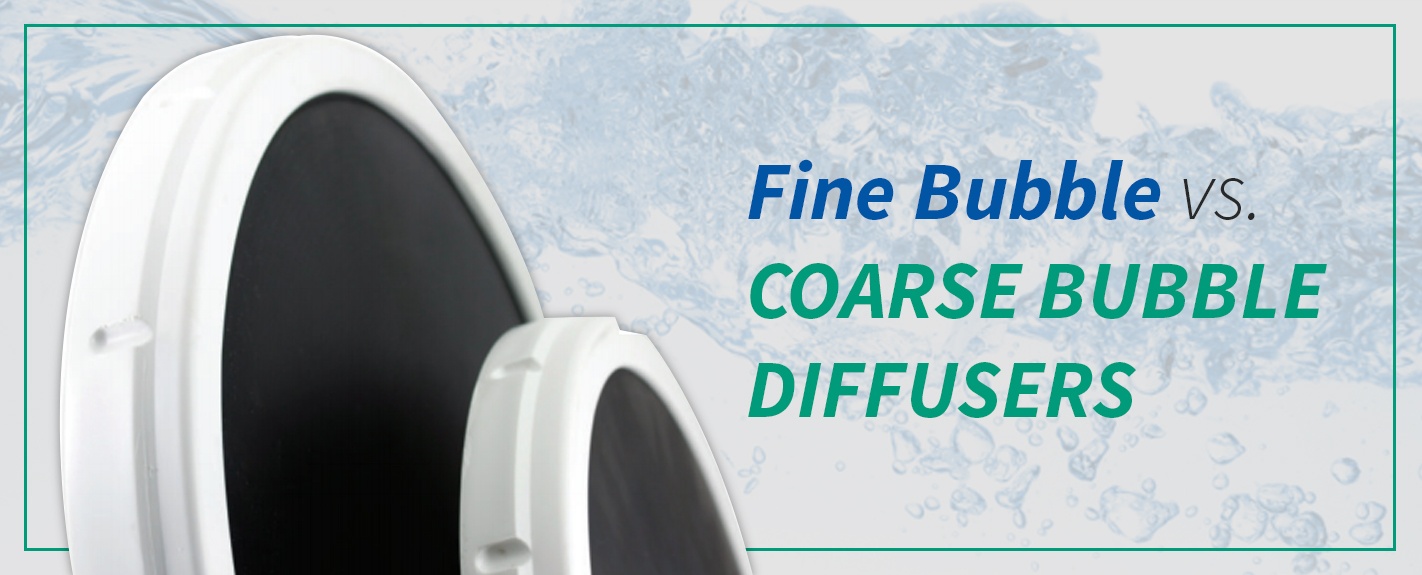
Table Of Contents
- WHAT’S THE DIFFERENCE?
- FINE BUBBLE DIFFUSERS: TYPES
- FINE BUBBLE DIFFUSERS: PROS
- FINE BUBBLE DIFFUSERS: CONS
- COARSE BUBBLE DIFFUSERS: TYPES
- COARSE BUBBLE DIFFUSERS: PROS
- COARSE BUBBLE DIFFUSERS: CONS
- CHOOSE THE RIGHT AERATION DIFFUSERS FOR YOUR APPLICATION
Fine Bubble Vs. Coarse Bubble Diffusers
Submerged bubble aeration is one of the most common methods of removing organic matter during primary and secondary wastewater treatment. It works effectively by diffusing small air bubbles to mix with the wastewater and facilitating the work of aerobic bacteria in breaking down organic waste. With its advanced system, many wastewater treatment facilities choose this method over surface aeration.
There are two types of bubble aeration: fine bubble and coarse bubble diffusers. Each has unique features and benefits that determine the most appropriate option for different facility needs.
When Are Fine Bubble Diffusers Necessary?
Fine bubble membrane diffusers produce a smaller-diameter bubble for the aeration process. This fine bubble aeration usually provides 2% or more Standard Oxygen Transfer Efficiency (SOTE) during aeration. They are an effective choice for more efficient aeration, oxygen transfer and energy use.
Fine Bubble and Coarse Bubble Diffusers: What’s the Difference?
Though fine bubble diffusers and coarse bubble diffusers both work through bubble aeration, it’s important to identify some distinguishing features of their design and function to determine which is appropriate.
Fine bubble membrane diffusers produce a smaller-diameter bubble for the aeration process. These bubbles typically measure 1 to 3 mm in diameter. This fine bubble aeration usually provides 2% or more Standard Oxygen Transfer Efficiency (SOTE) during aeration. Fine bubble diffusers come in a range of diameters themselves. At SSI Aeration, Inc., we offer 7-, 9- and 12-inch fine bubble diffusers designed for performance and durability in municipal and industrial use.
Coarse air bubble diffusers, in contrast, produce a larger diameter of bubble to displace, churn and mix the wastewater effectively. Coarse bubble aeration typically provides 1% or less SOTE during aeration. At SSI, we offer a range of coarse bubble diffusers at a variety of price points to ensure our long-lasting products, engineered to the highest standards, can fill every type of need.
When to Use Fine Bubble Diffusers
Fine bubble diffusers target a specific category of users, particularly those who want to focus on more environmentally friendly practices. Since fine bubble diffusers release smaller bubbles, they create more oxygen mass to allow air and water to combine for longer while covering a larger surface area. As a result, it uses less power to run with lower volatile organic compound emissions.
Fine Bubble Diffusers: Types
Fine bubble diffusers come in a few different styles of function and complexity. Below, you will find a short list of some fine bubble diffuser designs:
1. Disk
Disk diffusers consist of an EPDM rubber membrane mounted onto a plate.
SSI Aeration, Inc., offers a unique PTFE coating on the rubber membrane that is highly effective at combating bacterial coating and fouling. As compressed air flows through the membrane, the rubber expands. This expansion opens the constellation of small holes and releases thousands of bubbles into the water.
Disk diffusers are very effective in their function but can be more complex to install than other types of diffusers.

2. Tube
Tube diffusers consist of a long, narrow plastic or ceramic cylinder surrounded by an EPDM rubber membrane. Again, the rubber expands as compressed air flows through it to open the tiny holes and release small-diameter bubbles into the wastewater.
This type of fine bubble diffuser tends to have more surface area than disk diffusers and produces more bubbles. They require lower initial expenses than disk diffusers because they are simpler to install, though they are not always less expensive to maintain over the long term.
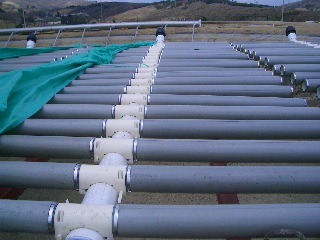
3. Perforated Tubing/Bubble Tubing
Though disk diffusers and tube diffusers make up two primary types of fine bubble diffusers, other types of fine bubble diffusers are available too, such as perforated tubing, or bubble tubing, diffusers. These consist of perforated plastic panels. Compressed air flows through and leaks out through the perforations.
Unlike with disk and tube diffusers, there is no expansion or contraction of the material to open the holes.
Fine Bubble Diffusers: Pros
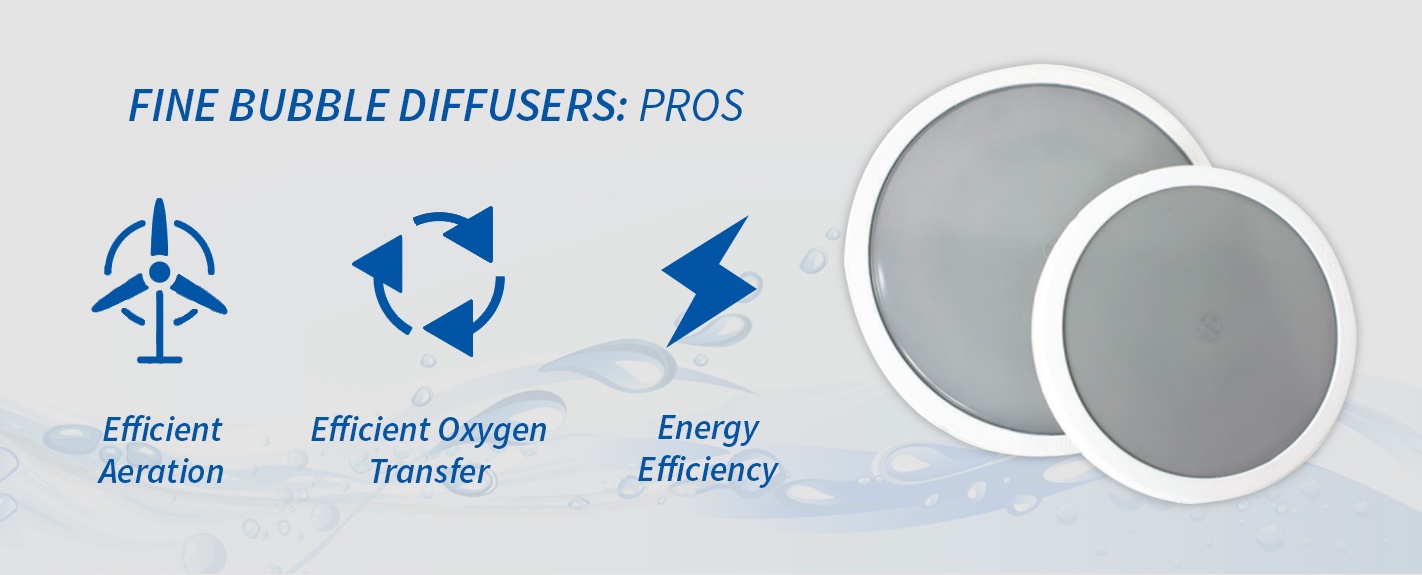
Below, you will find a discussion of some of the features that make fine bubble diffusers, both disk-type and tube-type, an effective choice for wastewater treatment.
1. Efficient Aeration
Standard Aeration Efficiency (SAE) is measured by the number of pounds of oxygen mixed into the wastewater per horsepower-hour as produced by the blowers that power the treatment system.
Fine bubble diffusers disperse more oxygen into the water column for more efficient aeration, typically producing more oxygen mass than comparable coarse bubble diffusers. Especially during secondary treatment, when wastewater must be purified to meet the EPA standard of removing hazardous elements, efficient aeration is a strong asset.
2. Efficient Oxygen Transfer
Standard Oxygen Transfer Efficiency (SOTE) refers to how efficiently the dispersed oxygen combines with the water in order for the aeration process to occur. A high number of tiny bubbles, like those produced with fine bubble diffusers, are able to transfer more oxygen into the water column than a smaller number of larger bubbles.
This increased oxygen transfer efficiency of aerators is the result of two factors:
- Surface area: A mass of many small bubbles has a much larger cumulative surface area than a few larger ones. This increased surface area allows for a higher rate of oxygen transfer as the air and water come into contact across the surfaces of the bubbles.
- Speed: Smaller bubbles rise at a slower rate than larger ones. This slow rate of speed results in a greater amount of contact time between air and water and permits more oxygen to be distributed throughout the water column. The increased time for oxygen transfer results in greater transfer efficiency.
All in all, the smaller bubbles produced by a fine bubble diffuser can accomplish the same amount of oxygen transfer with about half as much air as a coarse bubble diffuser would require.
3. Energy Efficiency
Energy efficiency is one of the most attractive enhancements fine bubble diffusers offer and is a primary reason why fine bubble diffusers have been so widely adopted.
In a typical wastewater treatment facility, 40% to 75% of the power requirements come from the aeration system. An energy-efficient diffuser leads to a reduction in power needs and results in significant savings for any treatment plant. Fine bubble diffusers generally cost less to operate than other types of aeration, like coarse bubble aeration, in terms of energy used. This is because the smaller amount of compressed air needed for a fine bubble diffuser makes fewer demands on the blowers that power the aeration system.
Fine Bubble Diffusers: Cons
Though fine bubble diffusers have a variety of benefits, they are not suited to every application. A few of the drawbacks of fine bubble diffusers are outlined below:
1. Low Alpha Factor
Alpha factor refers to the diffuser’s resistance to fouling. Ultra fine pore oxygen diffusers tend to become fouled more quickly than coarse bubble diffusers because the tiny pores are more susceptible to becoming clogged with bacteria and organic waste.
This low alpha factor has several consequences. First, the sludge buildup impairs the diffuser function and reduces its efficiency in aeration and oxygen transfer. Second, it sends back-pressure through the system, which can lead to increased wear and tear on the blowers. Finally, the quick rate of fouling means the diffusers must be cleaned and replaced more often, causing losses to the treatment facility in terms of both money and time.
2. Weaker Mixing
The smaller bubbles produced by fine bubble diffusers, while exceedingly efficient for aeration and oxygen transfer, are poorer at mixing. Their smaller volume in comparison to coarse bubble diffusers means they cannot displace the same amount of liquid.
In wastewater treatment, mixing is vital for keeping biosolids in suspension so they cannot settle in the water and form sludge, which makes the treatment process less efficient and is costly and time-consuming to remove. Mixing is also necessary for bringing microorganisms into contact with solid organic matter in order to break it down. Fine bubble diffusers provide less power to facilitate this process.
3. Complex Installation and Cleaning
Often, when it is necessary to install or clean the diffusers, the entire tank must be dewatered and desludged. This costs time — at least a week per cleaning — plus labor and money for the wastewater treatment facility. In some cases, if the diffusers are attached to floating laterals, the installation must occur while the diffuser is submerged in the wastewater, which can be more difficult and dangerous.
Coarse Bubble Diffusers: Types
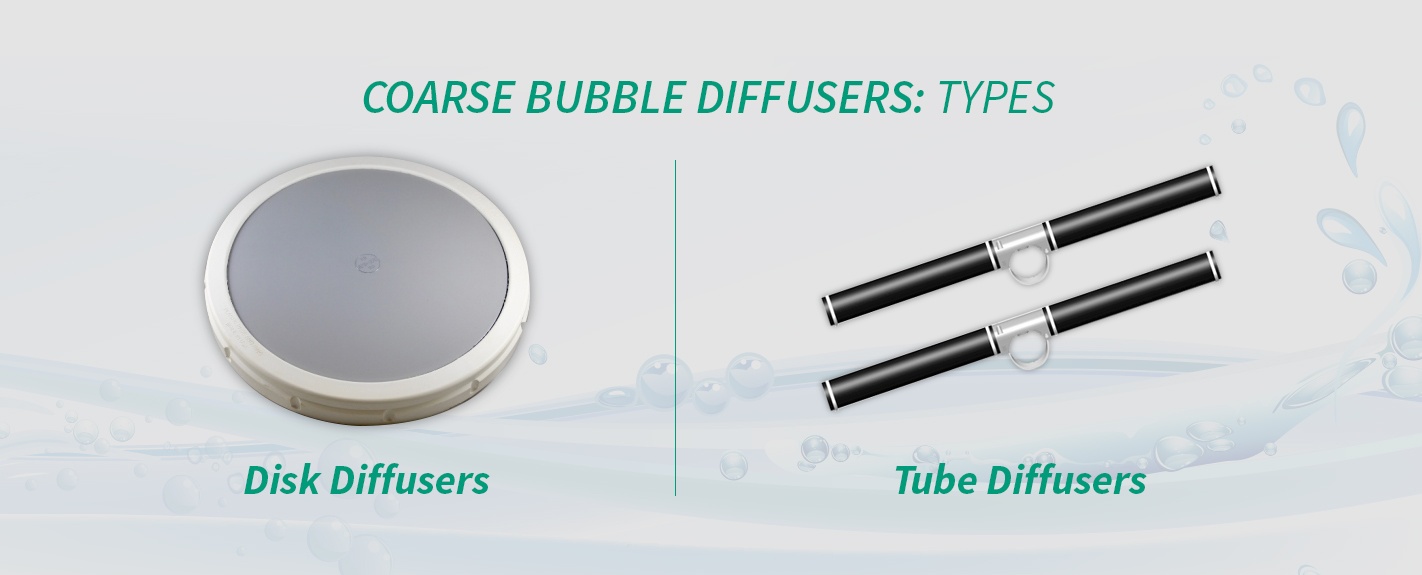
When to Use Coarse Bubble Diffusers
Coarse bubble diffusers have several advantages, especially in terms of durability and affordability. Choose this type for secondary treatment applications that need to eliminate the complex buildup of carbonate and sediment in larger spaces.
Now that we’ve discussed fine bubble diffusers and their pros and cons, we can investigate some of the benefits and drawbacks of coarse bubble diffusers. Coarse bubble diffusers, which can produce bubbles as large as 50 mm, come in a few different types, such as those listed below:
1. Disk Diffusers
The ReliaBall diffuser from SSI Aeration, Inc. is a coarse bubble disk diffuser. This type of diffuser typically consists of a wide band with perforated holes in it. Sometimes, this type of diffuser includes a cap with a membrane. Compressed air flows through the perforations and into the wastewater, producing large bubbles.
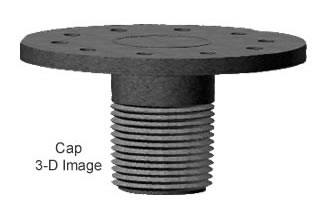
2. Tube Diffusers
Coarse bubble tube diffusers consist of a pipe or tube. This tube may have holes drilled into it or, in some cases, compressed air flows through the bottom of the tube. Orifices may be static or open and close with the flow of compressed air.
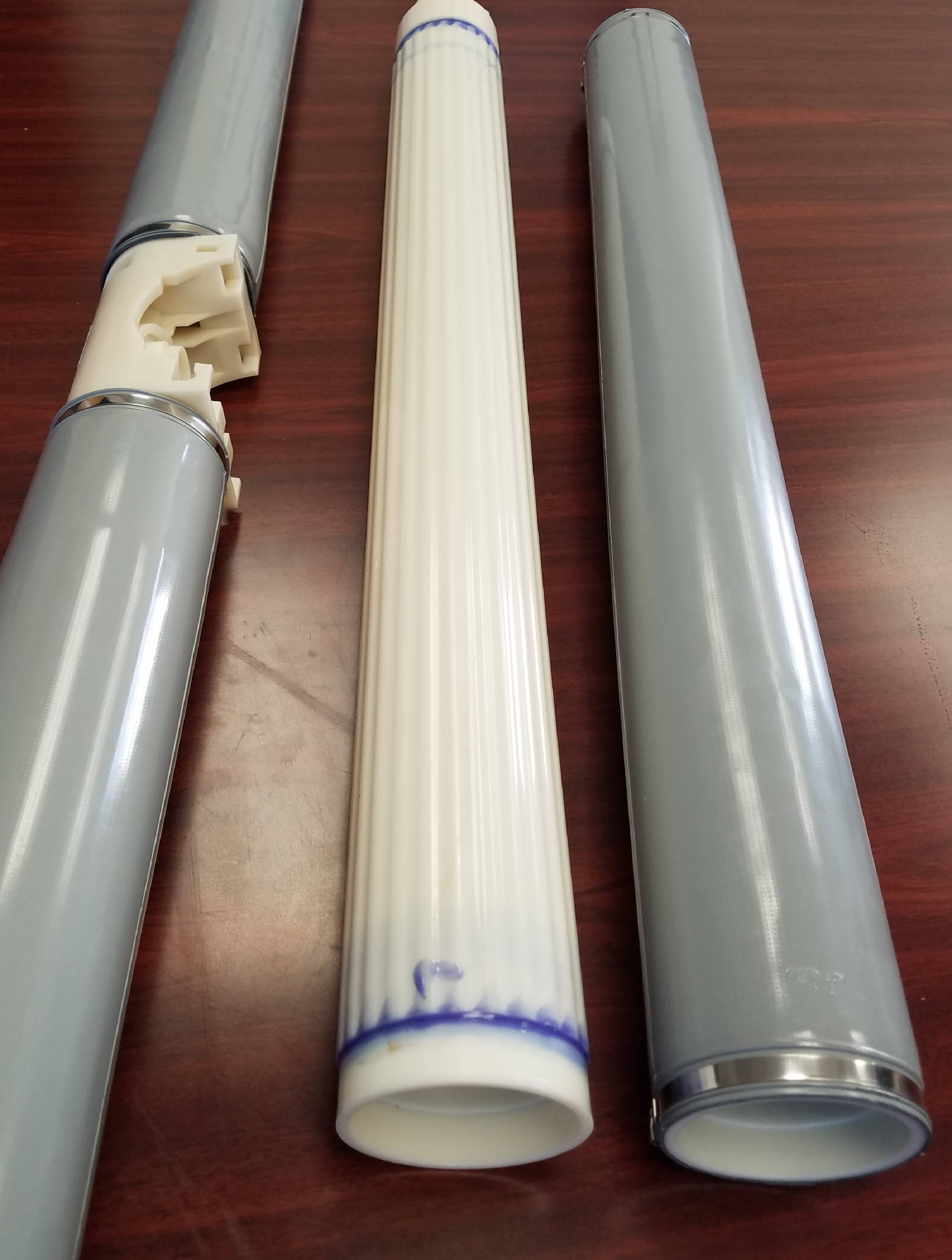
Coarse Bubble Diffusers: Pros
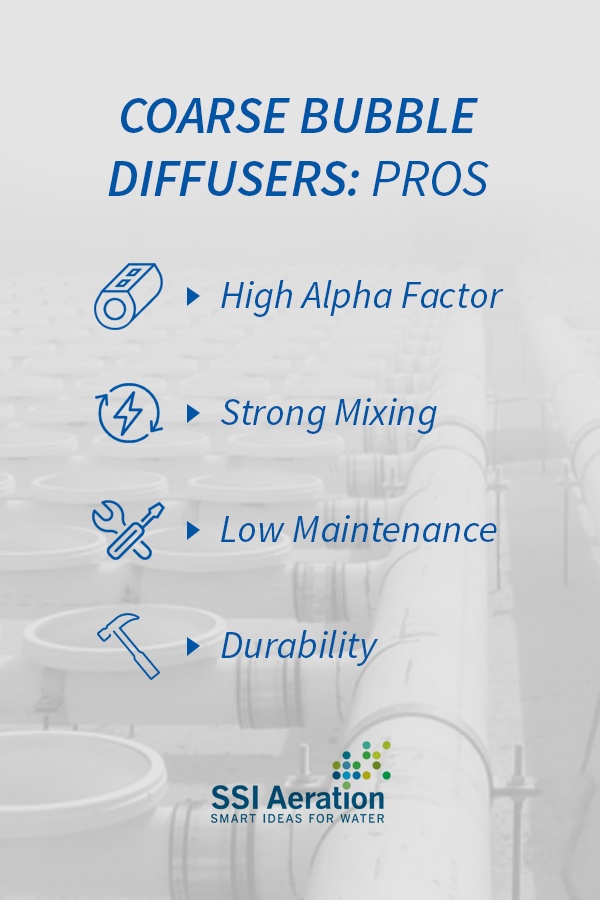
When Are Coarse Bubble Diffusers Necessary?
Coarse air bubble diffusers produce a larger bubble diameter to displace, churn and mix the wastewater. Coarse bubble aeration typically provides 1% or less SOTE during aeration. They are indispensable for waste treatment systems that need highly durable diffusers with strong mixing performance and high alpha factor for less maintenance and replacement.
Below, you will find a discussion of the best selling points of coarse bubble diffusers for wastewater treatment systems:
1. High Alpha Factor
The larger holes of coarse bubble diffusers mean the diffusers are less susceptible to fouling than fine bubble diffusers. Bacteria and biosolids are less likely to become trapped and encrusted in the perforations. This keeps the diffusers running efficiently and reduces back-pressure that would otherwise put wear and tear on the blowers.
2. Strong Mixing
The larger bubbles produced by coarse bubble diffusers have more volume, displace more waste liquid, and consequently produce more power for mixing. Biosolids are kept in suspension and are less likely to form unwanted sludge. The effective mixing of coarse bubble diffusers facilitates the breakdown of organic waste thanks to its powerful combination of oxygen, bacteria and waste material.
3. Low Maintenance
Coarse bubble diffusers’ larger pores mean the diffusers are less prone to clogging and require cleaning less frequently with a pressure washer or manual brush. This low maintenance saves the treatment facility money and time.
4. Durability
Enhanced resistance to fouling means the diffusers wear out and require replacement less frequently. The lessened burden of replacement likewise saves money.
Coarse Bubble Diffusers: Cons
Although coarse bubble diffusers offer strong benefits in their power and durability, it’s important for treatment facilities to consider the drawbacks of these diffusers, which are discussed below:
1. Less Efficient Oxygen Transfer
Coarse bubble diffusers produce fewer, larger bubbles that travel faster than those produced by fine bubble diffusers. Larger, faster bubbles transfer less oxygen into the water column. Typically, the SOTE of coarse bubble diffusers is less than 1%. To achieve the oxygen transfer efficiency of a comparable fine bubble diffuser, a coarse bubble diffuser would require twice as much air.
2. Less Efficient Aeration
Similarly, despite their increased vertical mixing power, coarse bubble diffusers disperse less oxygen into the water for less efficient aeration, typically achieving 50% or less of the efficiency achieved with fine bubble diffusers.
3. Less Energy Efficiency
Coarse bubble diffusers are generally less energy-efficient than fine bubble aeration. The amount of compressed air necessary for a coarse bubble diffuser to run puts greater demands on the blowers and a higher drain on the electrical system.
Choose the Right Aeration Diffusers for Your Application
Depending on your requirements, fine bubble or coarse bubble diffusers may have clear advantages for the work you need to do. Knowing how fine bubble and coarse bubble diffusers can be applied to the wastewater treatment process will help you reach a beneficial choice.
Deep Tanks
For deep, voluminous tanks, coarse bubble diffusers typically provide superior performance. Their premium vertical power means the organic material within the wastewater will be mixed sufficiently for proper breakdown and will remain in suspension without forming unwanted sludge.
Heavy Solids
For wastewater with a high composition of biosolids, coarse bubble diffusers perform well. The strong mixing performance enhances the breakdown of solids, and they are better suited than fine bubble diffusers to resisting the severe fouling that is likely to result from high biosolid composition. In locations such as equalization basins and grit chambers, coarse bubble diffusers outperform fine bubble diffusers.
Capital Cost Reduction
For companies where keeping costs low is a high priority, economy-line styles of coarse bubble diffusers provide a good fit while maintaining the high production quality that wastewater treatment facilities count on. In some cases, the innovative, economy-minded design is capable of reducing costs by 75%.
More Energy-Conscious Usage
For a company focused on shrinking its carbon footprint or pursuing a greener image, fine bubble diffusers make an ideal match, provided the facility has the resources necessary for more frequent and more painstaking cleanings of its diffusers. The efficient aeration and comparatively low energy use of fine bubble diffusers provide a high-performing fit for a forward-looking treatment facility.
Fine and Coarse Bubble Diffusers Recognized Worldwide at SSI Aeration, Inc.

Whether a facility needs fine bubble diffusers, coarse bubble diffusers or a combination of the two, SSI Aeration, Inc. can assist. We are a global leader in superior wastewater treatment solutions and services. Explore products with innovative designs, world-class engineering and time-tested quality to keep wastewater treatment systems functioning smoothly and efficiently.
SSI Aeration Inc. offers 7-, 9-, 12- and 20-inch fine bubble diffusers designed for performance and durability in municipal and industrial use. Different coarse bubble diffusers are also available for selection, including AFC Cap, ReliaBall and Wide Band diffusers to meet every facility requirement.
Contact us today to learn more about SSI Aeration Inc.’s diffusers, which are engineered to the highest standard.

Mr. Frankel co-founded SSI in 1995 with experience in design and distribution of engineered systems. He is in charge of sales, marketing and operations in the company. Mr. Frankel holds multiple US patents related to diffusers. He is a graduate of Washington University in St. Louis.

